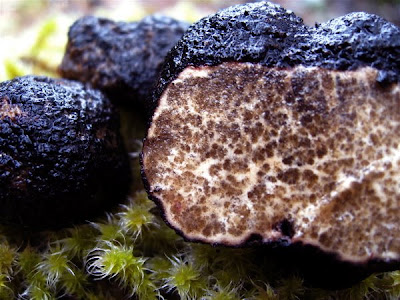
The truffle game is a steep learning curve. I made scouting missions here and here earlier this winter. Then I joined a few other rookies to go here. All three forays proved skunks. Last Friday I had the good fortune to meet a pair of would-be truffle hunters at the Survivor’s Banquet. L. and P., it turned out, lived on a Christmas tree farm in the Cascade foothills. Barely able to contain myself, I told them how truffle hunters down in Oregon were known to target such habitats. We made a date.
Yesterday I met another hopeful truffler, W., just off the highway and we proceeded to L. and P.’s home up the road. Huge century-old stumps decorated the property. Rows of Christmas trees dotted the meadows and older stands of mostly Douglas-fir filled out the remainder of the acreage. A steady rain swelled the five creeks that tumbled down off the ridge and gurgled across the property, one of which drove a Pelton wheel that powered the place. Piles of fresh elk droppings waited for an errant footfall. It was a magical setting to be sure.
Armed with potato rakes, we visited stand after stand without luck, guided by S., a cheerful 75-year-old local logger. We walked and raked, walked and raked. All the while the rain came down and runneled off our hoods. Truffles, it seemed, would continue to elude me. After lunch S. suggested we visit another timber stand he had worked on down the road. The trees here were about the same age class—20 to 30 years old—but they were packed in tighter, with less light filtering through, and hence, less undergrowth. S. grumbled about the poor thinning practices in this dense stand while the rest of us oohed and ahhed at what seemed like perfect truffle habitat: young Doug-firs, sparse groundcover, and a deep, loose duff composition.
L. struck paydirt first. She followed a vole hole with her rake and came away with a gumball-sized nugget. We all took a whiff. Yowza! Talk about a fecund, gnarly aroma. It smelled of overripe fruit and other more lusty odors. W. found a couple wormy ones past their prime, and then I unearthed a large, double-nobbed specimen. This one, though, lacked the pungent aroma of the first. I sliced it open. The marbling and soft, cheese-like interior gave it the textbook appearance of an Oregon black truffle, Leucangium carthusianum.
I am a truffle virgin no more.
To be honest, though, I think we’re late in the season for Oregon blacks. We were actually hoping to find the Oregon spring white truffle, Tuber gibbosum. These critters look to be a tad long in the tooth. One of my fellow mycophagists over at the Cascade Mycological Society‘s forum has suggested that these specimens exhibit evidence of frost damage, based on the dark marbling.
So now I’m waiting to see if the big one develops an aroma. I’ve got it wrapped in a paper napkin and sealed in a Ziplock in the fridge. I’ll know if it ripens because the whole kitchen will start to smell. More likely, my truffle is indeed frost-burned and will rot instead. That’s okay. Even if I don’t get to cook with it, I’m relieved to be off the schneid.

